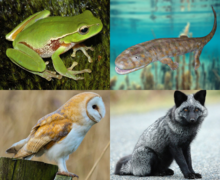Stegocephali
| Stegocephali | |
|---|---|

| |
| Examples of stegocephalians (clockwise from top left): Tyto alba
| |
| Scientific classification | |
| Domain: | Eukaryota |
| Kingdom: | Animalia |
| Phylum: | Chordata |
| Clade: | Sarcopterygii |
| Clade: | Tetrapodomorpha |
| Clade: | Elpistostegalia |
| Clade: | Stegocephali Cope, 1868 |
| Subgroups | |
|
See text. | |
Stegocephali (often spelled Stegocephalia, from
sarcopterygian
relatives.
Stegocephalians include both the modern lineage of limbed vertebrates (the
paleontologists
prefer a stricter definition of Tetrapoda which applies solely to the crown group, excluding earlier types of limbed tetrapodomorphs. Stegocephali was re-established to replace the broad definition of Tetrapoda, resolving the usage of two conflicting definitions in discussions of tetrapod evolution.
Stegocephali was coined in 1868 by the American paleontologist
Phylonyms, defines the group as including all taxa closer to Eryops than to Tiktaalik, Panderichthys, or Eusthenopteron.[4] The discovery of the Zachelmie trackways in 2010 suggests that stegocephalians possibly emerged 395 Ma or earlier.[5]
History of classification
mastodonsaurids and Bromsgroveia
Originally, the term was used as a
reptiles and their descendants) and modern lissamphibians
.
Paleontologist
Tetrapoda by those who sought to restrict Tetrapoda to the crown group.[8]
As such, it encompasses all presently living land vertebrates as well as their early amphibious ancestors.
Phylogeny
Below is an evolutionary tree of stegocephalians, as recovered from an analysis by Swartz in 2012.[9]
| Elpistostegalia |
| ||||||||||||
As recovered by Clack et al. 2016:[10]
| Elpistostegalia |
| ||||||||||||||||||
Tetrapoda
|
|
Subgroups
- †Elginerpetontidae
- †Aistopoda
- †Whatcheeriidae
- †Colosteidae
- †Adelospondyli
- †Baphetoidea
- †Embolomeri (a.k.a. Anthracosauria sensu stricto)
- Tetrapoda
- stem-Lissamphibia, likely equivalent to Temnospondyli)
- stem-Amniota, a.k.a. Anthracosauria sensu lato)
- Stegocephali incertae sedis
- †Acanthostega
- †Antlerpeton
- †Aytonerpeton
- †Brittagnathus
- †Crassigyrinus
- †Diploradus
- †Densignathus
- †Doragnathus
- †Elpistostege?
- †Hynerpeton
- †Ichthyerpeton
- †Ichthyostega
- †Jakubsonia
- †Koilops
- †Livoniana?
- †Mesanerpeton
- †Metaxygnathus
- †Occidens
- †Ossirarus
- †Parmastega
- †Perittodus
- †Sigournea
- †Sinostega
- †Tantallognathus
- †Tiktaalik?
- †Tulerpeton
- †Tutusius
- †Umzantsia
- †Ventastega
- †Ymeria
References
- ^ Cope E. D. 1868. Synopsis of the extinct Batrachia of North America. Proceedings of the Academy of Natural Sciences of Philadelphia: pp 208–221
- ^ a b Laurin M. (1998): The importance of global parsimony and historical bias in understanding tetrapod evolution. Part I-systematics, middle ear evolution, and jaw suspension. Annales des Sciences Naturelles, Zoologie, Paris, 13e Series 19: pp 1–42.
- PMID 11411292.
- ^ S2CID 242704712.
- S2CID 4428903.
- ^ Burmeister, H. (1850): Die Labyrinthodonten aus dem Saarbrücker Steinkohlengebirge, Dritte Abtheilung: der Geschichte der Deutschen Labyrinthodonten Archegosaurus. Berlin: G. Reimer, 74 pp.
- Romer, A. S., (1947, revised ed. 1966) Vertebrate Paleontology, University of Chicago Press, Chicago
- ^ Laurin & al. Terrestrial Vertebrates. Stegocephalians: Tetrapods and other digit-bearing vertebrates. Tree of life
- PMID 22448265.
- S2CID 22421017.

